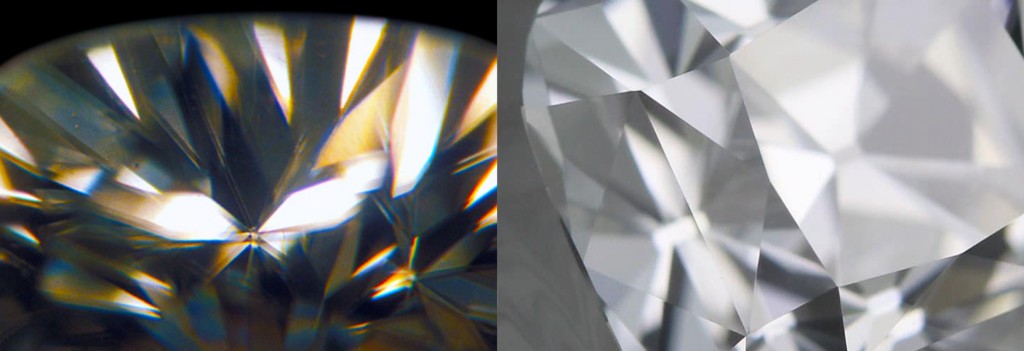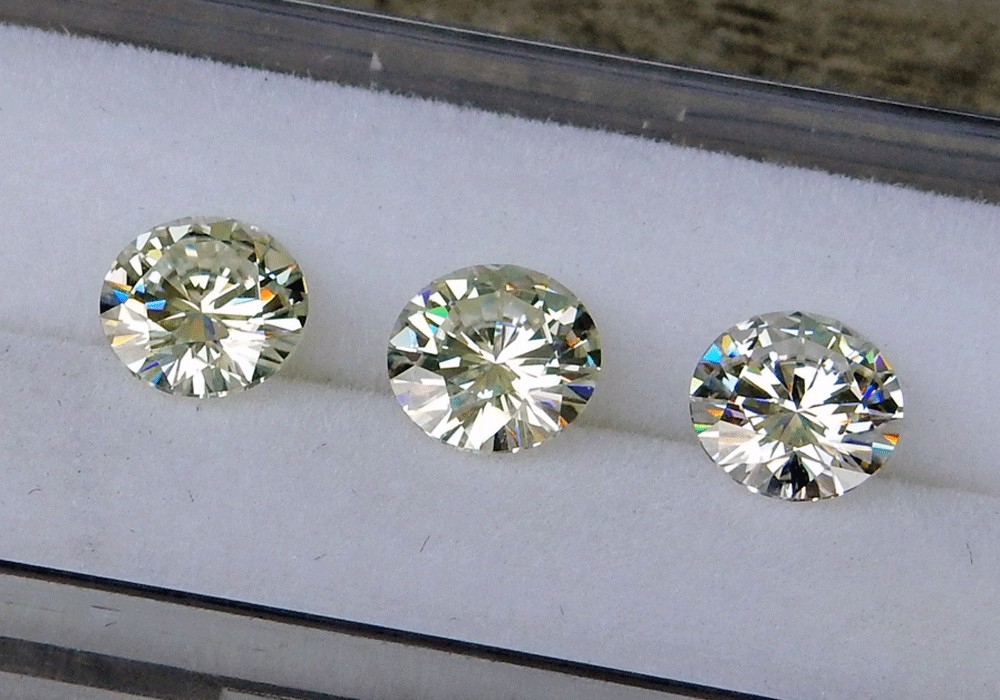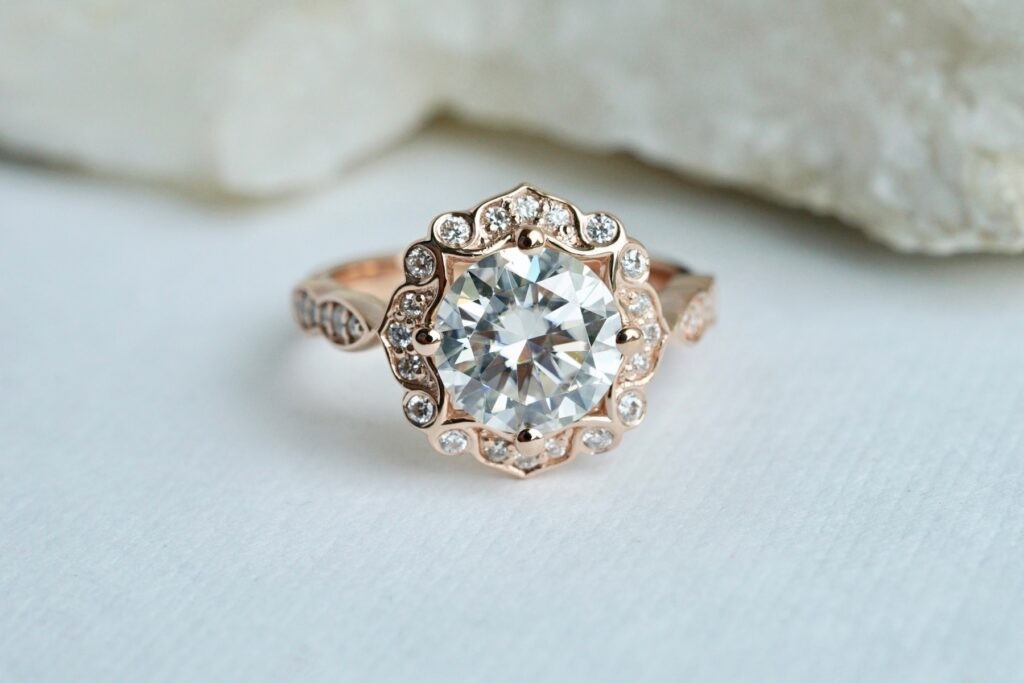Moissanite vs. diamonds: Understanding the price difference is key for couples seeking affordable engagement rings. COMPARE.EDU.VN offers insights into the financial aspects of these popular gemstones, helping you make an informed decision. Explore the cost-effectiveness, gemstone alternatives, and lab-grown options.
1. Understanding the Basics: Moissanite and Diamonds
Before diving into the price comparison, it’s crucial to understand what moissanite and diamonds are. Both are popular choices for jewelry, especially engagement rings, but they have distinct origins and properties.
1.1 What is Moissanite?
Moissanite is a naturally occurring silicon carbide mineral. However, natural moissanite is incredibly rare, as it was originally discovered in 1893 in a meteor crater. Therefore, the moissanite used in jewelry today is almost exclusively lab-grown.
- Composition: Silicon carbide (SiC)
- Origin: Originally discovered in a meteor crater; now primarily lab-created.
- Key Features: Known for its brilliance and fire, moissanite offers a unique sparkle that sets it apart from other gemstones.
1.2 What are Diamonds?
Diamonds are formed deep within the Earth under extreme heat and pressure, composed of pure carbon. They are renowned for their hardness, brilliance, and timeless appeal.
- Composition: Pure carbon (C)
- Origin: Formed naturally under extreme heat and pressure deep within the Earth.
- Key Features: Renowned for hardness, brilliance, and classic elegance.
2. Key Differences Between Moissanite and Diamonds
While both gemstones are beautiful and durable, they have several key differences that affect their price and appeal.
2.1 Brilliance and Sparkle
- Moissanite: Has a higher refractive index (2.65) than diamond (2.42), meaning it bends light more and produces more sparkle. Moissanite also exhibits a higher dispersion, resulting in more colored sparkle, often described as “fire.”
- Diamond: Offers a balance of white and rainbow sparkle. The sparkle of a diamond is more subdued and classic compared to the fiery brilliance of moissanite.
Moissanite vs Diamond Under Magnification: A closer look reveals distinct refractive properties
2.2 Reflection
- Moissanite: Is doubly refractive, meaning light splits into two rays as it passes through the stone. This can sometimes create a “double” effect when viewed closely.
- Diamond: Is singly refractive, providing a clearer and more defined reflection.
2.3 Color
- Moissanite: Can be colorless or near-colorless. The color grade can vary based on the type of moissanite, with “Forever One” moissanite being the highest quality, offering colorless options comparable to a GIA-certified E-color diamond.
- Diamond: Graded on a color scale from D (colorless) to Z (light yellow or brown). Colorless diamonds are more valuable due to their rarity and brilliance.
2.4 Hardness and Durability
- Moissanite: Rates 9.25 on the Mohs Scale of Hardness, making it very resistant to scratches and suitable for everyday wear.
- Diamond: Is the hardest known mineral, rating 10 on the Mohs Scale. While extremely durable, diamonds can be chipped if struck with enough force along their cleavage planes.
2.5 Ethical Considerations
- Moissanite: As a lab-created gemstone, moissanite is inherently conflict-free, ensuring ethical sourcing.
- Diamond: While efforts have been made to ensure ethical sourcing through initiatives like the Kimberley Process, concerns about conflict diamonds still exist. Lab-grown diamonds are also an ethical alternative.
3. How Expensive Is Moissanite Compared to Diamonds?
The most significant difference between moissanite and diamonds is the price. Moissanite is considerably more affordable, making it an attractive option for budget-conscious consumers.
3.1 Price Factors for Diamonds
The price of a diamond is determined by the “4 Cs”: Carat, Cut, Clarity, and Color.
- Carat: Refers to the weight and size of the diamond. Larger diamonds are rarer and more expensive.
- Cut: Affects the diamond’s brilliance and sparkle. A well-cut diamond reflects light effectively, enhancing its beauty.
- Clarity: Refers to the absence of inclusions (internal flaws) and blemishes (surface imperfections). Flawless diamonds are rare and highly valued.
- Color: Ranges from D (colorless) to Z (light yellow or brown). Colorless diamonds are the most desirable and expensive.
3.2 Price Factors for Moissanite
The price of moissanite is primarily determined by its size and type (e.g., classic, near-colorless, Forever One). Unlike diamonds, the price of moissanite does not vary significantly based on cut or clarity.
- Size: Larger moissanite stones are more expensive.
- Type: “Forever One” colorless moissanite is the most expensive type due to its superior color and brilliance.
3.3 Comparative Price Table
To illustrate the price difference, consider the following table comparing the cost of diamonds and moissanite of similar sizes:
| Carat Size | GIA Certified Diamond (Round, I-color, VS2) | Classic Moissanite | Near Colorless Moissanite | Forever One Colorless Moissanite |
|---|---|---|---|---|
| 0.5 | $1,100+ | $89 | $243 | $269 |
| 1.0 | $4,000+ | $269 | $539 | $599 |
| 1.5 | $10,000+ | $449 | $945 | $1,049 |



Note: Prices are approximate and may vary depending on the vendor and specific stone characteristics.
As the table indicates, moissanite is significantly less expensive than diamonds. For example, a 1-carat Forever One colorless moissanite costs around $599, while a comparable GIA-certified diamond costs $4,000 or more.
3.4 Cost Savings and Budget Allocation
Choosing moissanite over a diamond can result in substantial cost savings. These savings can be allocated to other important aspects of life, such as:
- Homeownership: Putting a down payment on a house.
- Travel: Funding a dream vacation.
- Investments: Securing financial future through investments.
- Experiences: Creating lasting memories through various activities.
4. Intended Search Queries and Detailed Answers
To fully address user intent, let’s explore common search queries related to the cost comparison of moissanite and diamonds.
4.1 “Is Moissanite Cheaper Than Diamond?”
Yes, moissanite is significantly cheaper than diamonds. The price difference can be substantial, with moissanite costing a fraction of the price of a comparable diamond. This makes moissanite an attractive option for those seeking a beautiful and durable gemstone at a more affordable price point.
4.2 “How Much Can I Save by Choosing Moissanite?”
The amount you can save by choosing moissanite depends on the size and quality of the stone. Generally, you can save anywhere from 50% to 90% compared to the cost of a diamond. For example, a 1-carat diamond might cost $4,000 or more, while a 1-carat moissanite of similar quality can be purchased for under $600.
4.3 “What Are the Pros and Cons of Buying Moissanite?”
Pros:
- Affordability: Significantly less expensive than diamonds.
- Brilliance: Exhibits more fire and sparkle than diamonds.
- Durability: High hardness rating (9.25 on the Mohs Scale) makes it suitable for everyday wear.
- Ethical Sourcing: Lab-created, ensuring conflict-free origin.
- Unique Appeal: Offers a distinct look with its intense sparkle and fire.
Cons:
- Not a Diamond: Some people prefer the prestige and traditional appeal of a diamond.
- Double Refraction: Can create a “double” effect when viewed closely, which may not appeal to everyone.
- Resale Value: May not hold its value as well as diamonds.
4.4 “Is Moissanite a Good Alternative to Diamond for Engagement Rings?”
Yes, moissanite is an excellent alternative to diamonds for engagement rings. It offers similar durability and brilliance at a fraction of the cost. Many couples choose moissanite to save money without compromising on the beauty and quality of their ring.
4.5 “Where Can I Buy High-Quality Moissanite?”
High-quality moissanite can be purchased from reputable jewelers, both online and in brick-and-mortar stores. Look for vendors who offer “Forever One” moissanite, which is known for its superior color and brilliance. It’s also important to check customer reviews and ensure the vendor has a good return policy. Consider exploring options at COMPARE.EDU.VN for trusted retailers.
5. Detailed Comparison: Moissanite vs. Diamond Attributes
To provide a comprehensive comparison, let’s delve into specific attributes and how moissanite and diamonds measure up.
5.1 Composition and Origin
| Feature | Moissanite | Diamond |
|---|---|---|
| Composition | Silicon Carbide (SiC) | Pure Carbon (C) |
| Origin | Primarily Lab-Grown | Natural (Mined) or Lab-Grown |
| Ethical Concerns | Conflict-Free | Potential for Conflict Diamonds |
| Availability | Readily Available | Can be Scarce Depending on Quality |
5.2 Optical Properties
| Feature | Moissanite | Diamond |
|---|---|---|
| Refractive Index | 2.65 | 2.42 |
| Dispersion | 0.104 | 0.044 |
| Reflection | Doubly Refractive | Singly Refractive |
| Brilliance | High, Intense Sparkle | Balanced White and Rainbow |
| Fire (Colored Sparkle) | Very High | Moderate |
5.3 Durability and Wear
| Feature | Moissanite | Diamond |
|---|---|---|
| Hardness (Mohs Scale) | 9.25 | 10 |
| Scratch Resistance | Excellent | Exceptional |
| Chip Resistance | Good | Can Chip Along Cleavage Planes |
| Daily Wear | Highly Suitable | Highly Suitable |
5.4 Color and Clarity
| Feature | Moissanite | Diamond |
|---|---|---|
| Color Range | Colorless to Near-Colorless | D (Colorless) to Z (Light Yellow/Brown) |
| Clarity | Generally Eye-Clean | Varies Based on Inclusions and Blemishes |
| Color Grading | Type Dependent (e.g., Forever One) | GIA Color Grading Scale |
| Clarity Grading | Not Typically Graded Like Diamonds | GIA Clarity Grading Scale |
6. Moissanite Varieties: Classic, Near Colorless, and Forever One
Understanding the different types of moissanite is crucial when evaluating cost and quality.
6.1 Classic Moissanite
Classic moissanite was the first type of lab-created moissanite. It often exhibits a greenish-yellow hue, making it less desirable for those seeking a colorless stone.
- Color: Typically has a noticeable greenish-yellow tint.
- Price: Generally the most affordable type of moissanite.
6.2 Near Colorless Moissanite
Near colorless moissanite is a step up from classic moissanite, with a less pronounced tint. However, it may still exhibit some color under certain lighting conditions.
- Color: Exhibits a slight tint, but less noticeable than classic moissanite.
- Price: Moderately priced, offering a good balance of quality and affordability.
6.3 Forever One Moissanite
Forever One moissanite is the highest quality moissanite available. It is engineered to be colorless, rivaling the appearance of high-grade diamonds.
- Color: Colorless, comparable to a GIA-certified E-color diamond.
- Price: The most expensive type of moissanite, but still significantly cheaper than diamonds.
Classic Moissanite (left) vs Near Colorless Moissanite (center) vs Forever One Colorless Moissanite (right): Comparing the color variations.
7. Moissanite Cuts and Shapes: Maximizing Brilliance
The cut and shape of a moissanite stone can significantly impact its brilliance and overall appearance.
7.1 Popular Cuts
- Round Brilliant: The most popular cut for both diamonds and moissanite, known for its exceptional brilliance and sparkle.
- Princess Cut: A square cut that offers a modern and sophisticated look.
- Cushion Cut: A classic cut with rounded corners, providing a soft and romantic feel.
- Oval Cut: An elongated cut that can make the finger appear longer and more slender.
- Emerald Cut: A step-cut with a rectangular shape, known for its elegant and understated appeal.
7.2 Hearts and Arrows Cut
The Hearts and Arrows cut is a precision cutting technique that maximizes the brilliance and fire of a gemstone. When viewed under a special scope, these stones exhibit a pattern of hearts and arrows.
- Benefits: Enhanced brilliance, symmetrical light reflection, and unique visual appeal.
- Availability: Primarily available in round and cushion shapes.
7.3 Shapes That Mimic Diamonds
Certain shapes can make moissanite appear more like a diamond. These include:
- Emerald and Asscher Cuts: These step-cuts have a sheen rather than intense sparkle, resembling the subtle elegance of diamonds.
8. Caring for Moissanite Jewelry
Maintaining the brilliance of moissanite jewelry is simple and straightforward.
8.1 Cleaning Tips
- Regular Cleaning: Clean your moissanite jewelry regularly with mild soap and warm water.
- Gentle Scrubbing: Use a soft brush to gently scrub away any dirt or grime.
- Avoid Harsh Chemicals: Avoid using harsh chemicals or abrasive cleaners, as they can damage the stone.
- Professional Cleaning: Consider professional cleaning and inspection to maintain its sparkle.
8.2 Storage
- Separate Storage: Store your moissanite jewelry separately from other jewelry to prevent scratches.
- Protective Pouches: Use soft pouches or jewelry boxes to protect the stones from damage.
8.3 Everyday Wear
- Wear with Confidence: Moissanite’s hardness makes it ideal for everyday wear.
- Avoid Extreme Impact: While durable, avoid exposing your moissanite jewelry to extreme impact or pressure.
9. Ethical and Environmental Considerations
Choosing moissanite offers significant ethical and environmental advantages over mined diamonds.
9.1 Conflict-Free Guarantee
Moissanite is lab-created, ensuring a conflict-free origin. This eliminates concerns about funding armed conflicts or human rights abuses associated with diamond mining.
9.2 Environmental Impact
Lab-grown moissanite has a smaller environmental footprint compared to mined diamonds. The production process requires less energy and resources, reducing habitat destruction and pollution.
9.3 Sustainable Choice
Choosing moissanite supports sustainable practices in the jewelry industry. It reduces the demand for mined gemstones, promoting a more environmentally responsible approach.
10. Is Moissanite Worth Buying? Real Customer Perspectives
Determining whether moissanite is worth buying involves considering individual preferences, budget constraints, and priorities.
10.1 Budget-Conscious Couples
For couples on a budget, moissanite offers an excellent way to achieve a beautiful engagement ring without breaking the bank. The cost savings can be used for other important life goals.
10.2 Ethical Consumers
Those concerned about ethical sourcing and environmental impact will appreciate the conflict-free and sustainable nature of moissanite.
10.3 Trendsetters
Moissanite is a great option for those who appreciate its unique sparkle and fire, setting it apart from traditional diamonds.
Moissanite engagement ring: A vintage halo design showcasing the stone’s unique brilliance
10.4 Happy Moissanite Customers
Many customers are delighted with their moissanite jewelry, praising its beauty, durability, and affordability. Numerous online reviews and testimonials highlight the satisfaction of moissanite buyers.
11. Diamond Alternatives: Expanding Your Options
While moissanite is a popular choice, several other diamond alternatives offer unique aesthetics and price points.
11.1 Lab-Grown Diamonds
Lab-grown diamonds are real diamonds created in a laboratory setting. They have the same chemical and physical properties as mined diamonds but are often more affordable and ethically sourced.
11.2 Sapphires
Sapphires come in a variety of colors, including white, and offer a durable and beautiful alternative to diamonds. White sapphires can be a more budget-friendly option, but they lack the brilliance of diamonds or moissanite.
11.3 Cubic Zirconia (CZ)
Cubic zirconia is a synthetic gemstone that closely resembles diamonds. It is very affordable but less durable and brilliant than moissanite or diamonds.
11.4 Morganite
Morganite is a pink to peach-colored gemstone that offers a romantic and feminine alternative to diamonds. It is relatively durable and can be a beautiful choice for engagement rings.
12. Making the Right Choice: Factors to Consider
Choosing between moissanite and diamonds, or other alternatives, depends on your personal preferences and priorities.
12.1 Budget
Consider how much you are willing to spend on an engagement ring. Moissanite is a great option for those with a limited budget.
12.2 Personal Style
Think about the style and aesthetic you prefer. Do you want the classic elegance of a diamond or the unique sparkle of moissanite?
12.3 Ethical Considerations
If ethical sourcing is important to you, moissanite or lab-grown diamonds are excellent choices.
12.4 Durability Needs
Consider your lifestyle and how durable you need the gemstone to be. Moissanite and diamonds are both highly durable and suitable for everyday wear.
13. Expert Advice: Consulting with Jewelers
Seeking advice from experienced jewelers can provide valuable insights and guidance in making your decision.
13.1 In-Person Consultations
Visit local jewelers to see moissanite and diamonds in person. This allows you to compare their appearance and ask questions.
13.2 Online Research
Research reputable online jewelers and read customer reviews. Look for vendors who offer detailed information and excellent customer service.
13.3 Questions to Ask
- What is the quality of the moissanite or diamond?
- What is the return policy?
- Can I see the stone in person before purchasing?
- Do you offer financing options?
14. Frequently Asked Questions (FAQs)
Here are some frequently asked questions related to moissanite and diamond comparisons:
Q1: Will moissanite fade or lose its sparkle over time?
No, moissanite will not fade or lose its sparkle over time. Its superior hardness and refractive index ensure it remains brilliant for life.
Q2: Can a jeweler tell the difference between moissanite and diamond?
Yes, a jeweler can typically tell the difference between moissanite and diamond using specialized equipment or by examining the stone closely.
Q3: Is moissanite a “fake” diamond?
No, moissanite is not a “fake” diamond. It is a distinct gemstone with its own unique properties and characteristics.
Q4: Does moissanite come with a certificate?
Yes, high-quality moissanite, such as Forever One, often comes with a certificate of authenticity.
Q5: Can I customize my engagement ring with moissanite?
Yes, you can customize your engagement ring with moissanite. Most jewelers offer custom design services.
Q6: How does lab-grown diamond compare to moissanite in price?
Lab-grown diamonds are generally more expensive than moissanite but less expensive than mined diamonds.
Q7: Are there any disadvantages to choosing moissanite over a diamond?
The main disadvantage is that moissanite does not have the same prestige and traditional appeal as a diamond.
Q8: Can moissanite be used in other types of jewelry besides engagement rings?
Yes, moissanite can be used in various types of jewelry, including earrings, necklaces, and bracelets.
Q9: What is the resale value of moissanite compared to diamonds?
The resale value of moissanite is generally lower than that of diamonds.
Q10: How do I care for moissanite jewelry to keep it sparkling?
Clean your moissanite jewelry regularly with mild soap and warm water, and avoid harsh chemicals.
15. Conclusion: Making an Informed Decision
Choosing between moissanite and diamonds involves carefully considering your budget, personal style, and ethical values. Moissanite offers an affordable, durable, and ethically sourced alternative to diamonds, while diamonds provide timeless elegance and prestige. By understanding the key differences and consulting with experts, you can make an informed decision that aligns with your needs and preferences.
Ready to explore more options and make the best choice for your special occasion? Visit COMPARE.EDU.VN today to discover detailed comparisons, expert reviews, and valuable insights that will guide you in your decision-making process. At COMPARE.EDU.VN, we’re dedicated to providing you with the information you need to make confident and informed choices. Our comprehensive comparisons, detailed analysis, and user reviews ensure that you have all the necessary details at your fingertips. Don’t settle for less; let COMPARE.EDU.VN help you make the perfect selection.
Visit us at 333 Comparison Plaza, Choice City, CA 90210, United States. Contact us via Whatsapp at +1 (626) 555-9090 or explore our website at compare.edu.vn.
